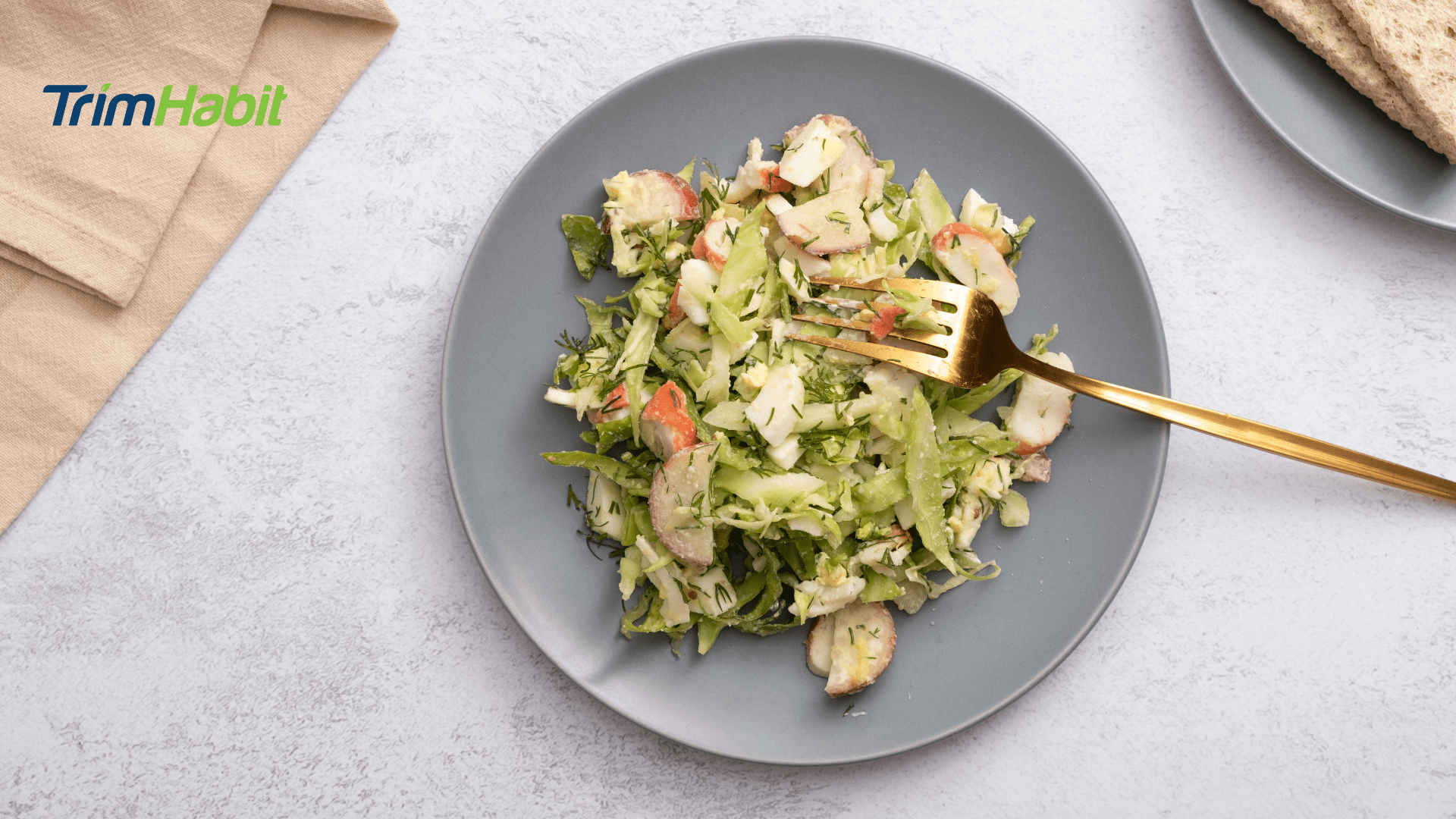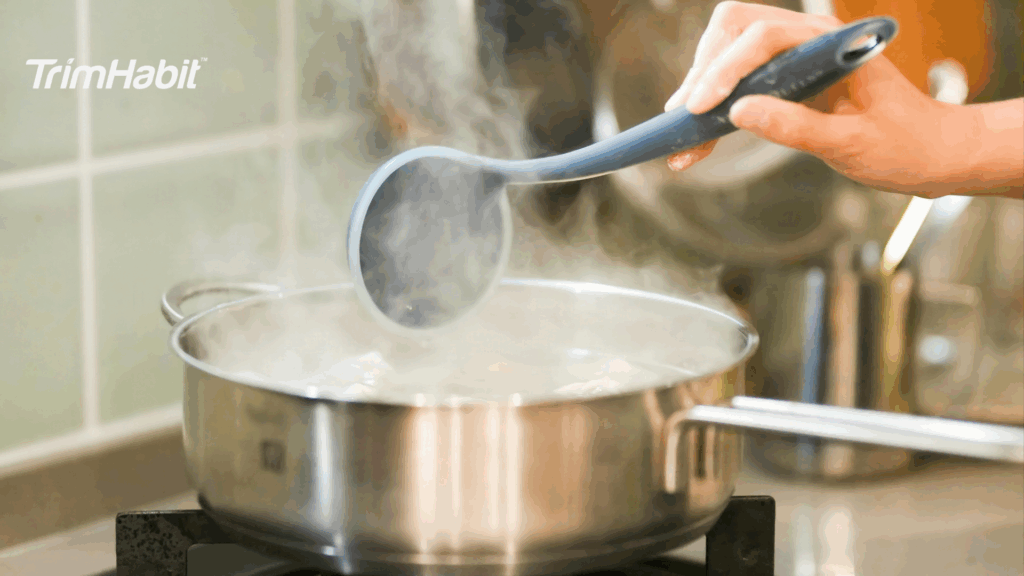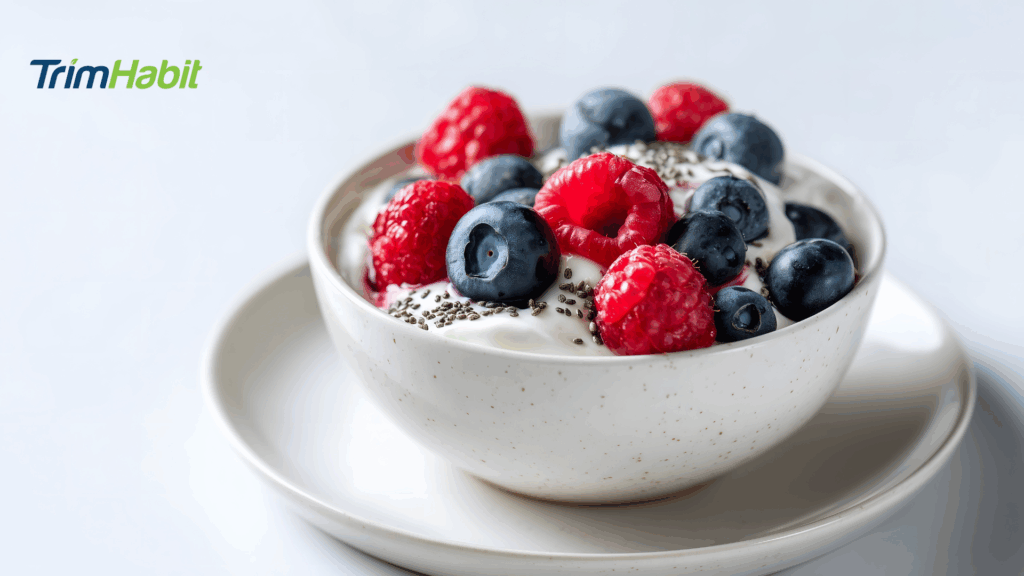If you’re taking semaglutide, whether as Ozempic, Wegovy, or another brand, you’re likely already aware of its ability to reduce appetite and help people lose weight.
But learning how to eat smaller portions on semaglutide is not just about relying on the medication. It’s about working with your body, recognizing new signals, and building sustainable habits that help you feel satisfied with less food.
Understanding How Semaglutide Works
Semaglutide is a medication originally developed to help manage blood sugar in people with type 2 diabetes. Its active ingredient mimics a hormone called GLP-1, which plays a role in appetite regulation and digestion1,2.
When you take semaglutide injections, they help you feel full sooner, slow gastric emptying, and signal your brain to reduce hunger. As a result, your calorie intake naturally decreases, leading to reduced body weight over time.
But while semaglutide can make a significant difference, it’s not magic. Long-term changes come when you adapt your meals, reduce portion sizes, and choose nutrient-dense foods that fuel your body.
Why Smaller Portions Matter On Semaglutide
The medication makes it easier to eat less food, but if you continue eating large portions out of habit, discomfort or nausea may follow. That’s because semaglutide slows down digestion, and large meals can feel much heavier than they used to.
Eating smaller portions helps:
- Prevent side effects of semaglutide like bloating and nausea
- Improve digestive health
- Support steady weight loss
- Reinforce healthy habits
Letting go of large portions isn’t about deprivation. It’s about understanding what your body actually needs now that you’re not constantly battling hunger.
Top Tips For Eating Smaller Portions
1. Use Smaller Plates and Bowls
Your brain plays a part in how full you feel. Swapping dinner plates for salad plates can help you serve less food without feeling like you’re missing out. The visual cue of a full plate still satisfies the eye, even if the portion size is reduced.
2. Slow Down While Eating
Take your time with each bite. Put your fork down between bites, chew thoroughly, and give your body time to register fullness. Since semaglutide helps your stomach empty more slowly, eating too fast can lead to discomfort before your body has the chance to say, “stop eating.”
3. Focus on Lean Proteins and Non-Starchy Vegetables
Lean proteins like chicken breast, turkey, fish, tofu, and eggs are filling without being high in calories. Combine them with non-starchy vegetables like broccoli, spinach, cauliflower, zucchini, and bell peppers to create meals that feel hearty without being heavy.
4. Cut High-fat and Fried Foods
Fried foods and high-fat foods may trigger nausea, especially while your body is adjusting to the medication. They’re also calorie-dense, which makes it harder to maintain a calorie deficit. Instead, focus on healthy fats like avocado, olive oil, and hemp seeds in small amounts.
5. Plan Your Meals
Meal planning reduces the chance of overeating or grabbing whatever’s available when you’re overly hungry. A balanced semaglutide diet plan includes whole grains, lean protein, non-starchy vegetables, and healthy fats in modest portions.
6. Avoid Drinking Calories
Liquid calories don’t trigger satiety as effectively as solid foods. Avoid sugary drinks, shakes, and excessive alcohol intake. These not only increase your calorie intake but can also interfere with blood sugar levels and hydration.
7. Pause Before Going for Seconds
Semaglutide can help you feel full faster, but sometimes it takes a few minutes. Wait 10–15 minutes after finishing your first portion. During that time, ask yourself if you’re actually still hungry or just eating out of habit.
8. Stay Hydrated Throughout the Day
Water helps regulate appetite and supports digestion. Sometimes, what feels like hunger is actually dehydration. Drink water throughout the day and before meals to help your body feel satisfied with less food.
9. Limit Foods High in Sugar and Processed Carbs
These foods cause spikes in blood sugar followed by crashes that can leave you feeling hungrier sooner. Opt for whole grains, fruits in moderation, and vegetables to keep blood sugar levels steady and cravings in check.
10. Embrace Nutrient Dense Foods
A small serving of roasted vegetables with quinoa and grilled chicken can be more filling and nourishing than a large plate of white pasta with butter. Nutrient-dense foods give your body what it needs in fewer calories.
What To Eat When You’re Taking Semaglutide
If you’re wondering about the best foods to eat on this medication, focus on those that are easier to digest and help regulate blood sugar. This includes:
- Greek yogurt (low sugar, high protein)
- Eggs (boiled, scrambled, poached)
- Cooked vegetables (easier to digest than raw in some cases)
- Whole grains (like brown rice, oats, farro)
- Berries (small portions)
- Legumes (lentils, chickpeas in modest amounts)
- Lean meats (skinless poultry, fish)
- Healthy fats (avocado, olive oil, hemp seeds)
Avoid heavy, greasy meals and instead create a routine built around a healthy diet that supports your weight loss goals.
Adjusting To The Feeling Of Fullness
When starting semaglutide, you may notice that your normal portion sizes feel like too much. This can be strange at first. The key is to listen to your body. The goal is to feel satisfied, not stuffed. This takes practice, especially if you previously relied on large portions.
It’s also normal to experience nausea or bloating as you adjust. To reduce these side effects:
- Eat smaller, more frequent meals
- Avoid lying down right after eating
- Choose lighter foods when you experience nausea
- If side effects persist, talk to your healthcare provider about adjusting your dosage or managing symptoms.
Building A Long-Term Relationship With Food
Semaglutide can help you lose weight, but it works best when combined with healthy habits. That includes regular physical activity, eating a balanced diet, managing stress, and prioritizing sleep.
This is not about eating perfectly. It’s about building a sustainable rhythm that helps your body stay nourished, satisfied, and energized. Smaller portions, better food quality, and smarter eating patterns can make a significant difference in how you feel day to day.
What Can Happen If You Don’t Adjust Portion Sizes
Sticking to your old portion sizes while taking semaglutide can lead to several problems:
1. Increased Side Effects
Eating large meals can overwhelm the digestive system while it’s slowed down. This raises the chances of nausea, bloating, acid reflux, and even vomiting.
2. Poor Blood Sugar Control
Semaglutide helps manage blood sugar levels, but large, carb-heavy meals can spike glucose and work against that benefit.
3. Stalled Weight Loss
Even with reduced appetite, eating large portions can result in more calories than your body needs. This can slow or stop weight loss altogether.
4. Discomfort After Meals
People often feel full faster on semaglutide. Ignoring that and eating until the plate is clean can cause prolonged fullness and discomfort that lasts for hours.
5. Missed Opportunity to Build Better Habits
Semaglutide creates a natural break in eating patterns. Continuing with oversized portions can lead to long-term dependence on the medication without learning sustainable habits.
A Note On Exercise
While food is key, movement matters too. Regular physical activity helps burn calories, maintain muscle mass, and improve your relationship with your body. Whether it’s walking, strength training, swimming, or dancing in your living room, find what you enjoy and make it a regular part of your routine.
Exercise not only helps with weight loss but also enhances your digestive system, reduces blood pressure, and boosts mood. It complements the effects of semaglutide injections and supports your weight loss goals more completely.
When To Talk To Your Healthcare Provider
Semaglutide injections, like Ozempic and Wegovy, are effective for weight management, but they’re still medication. Your healthcare provider can help tailor your plan, evaluate your starting weight, and monitor any potential side effects. They may also help you set realistic weight loss goals and ensure your body is responding well.
If you notice intense side effects or feel unsure about what to eat, get guidance. You don’t need to figure it all out on your own.
Talk to your provider if:
- You experience persistent nausea, vomiting, or diarrhea
- You’re losing weight too quickly or too slowly
- You need help building a meal plan
- You’re concerned about nutrient intake or digestion
Final Thoughts: How To Eat Smaller Portions On Semaglutid
Learning how to eat smaller portions on semaglutide is a skill that gets easier with time. The medication gives you a head start, but your daily choices around food, movement, and portion sizes create the lasting impact. Every small change helps your body shed excess weight, improve blood sugar, and maintain a healthy weight loss pattern that supports long-term health.
You don’t have to be perfect to see progress. Pay attention to how you feel, focus on the quality of your meals, and trust that your body is learning how to thrive with less food.
A healthy diet filled with lean proteins, non-starchy vegetables, whole grains, and nutrient-dense ingredients will help you feel satisfied, reduce calorie intake, and stay on track with your weight loss injections. The goal is to find balance, nourish your body, and eat in a way that supports long-term well-being without relying on large portions.
Smaller portions are not a punishment. They’re part of learning to eat in a way that supports better health, weight, and energy every day.









